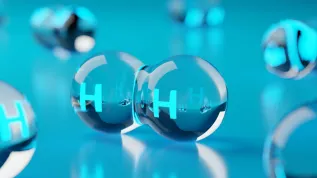
High-energy ion collisions at the Large Hadron Collider are capable of producing a quark-gluon plasma. But are heavy atomic nuclei really necessary for its formation? And above all: how are secondary particles later born from this plasma? Further clues in the search for answers to these questions are provided by the latest analysis of collisions between protons and protons or ions, observed in the LHCb experiment.
When heavy atomic nuclei collide at the highest energies in the LHC, a quark-gluon plasma is created for an unimaginably brief moment. This is an exotic state of matter in which quarks and gluons, normally trapped in protons or neutrons, are no longer tightly bound together. This state is not permanent: as the temperature drops, the quarks and gluons rapidly hadronize, i.e. re-bond with each other, producing streams of secondary particles diverging at different angles. The details of the hadronization process, a phenomenon critical to our understanding of the foundations of physical reality, still remain a mystery. New clues have been provided by the just-completed analyses of collisions from the LHCb experiment, carried out with the participation of physicists from the Institute of Nuclear Physics of the Polish Academy of Sciences (IFJ PAN) in Cracow. The research, funded on the Polish side by the National Science Centre, was recently presented in the Journal of High Energy Physics.
“Hadronization occurs in timescales of yoctoseconds, i.e. trillionths of one trillionth of a second, over distances the size of femtometres, i.e. millionths of one billionth of a metre. Phenomena occurring so extremely fast and on such microscopic scales will not be directly observable for a long time to come – perhaps never. We are therefore trying to infer what is happening to the quark-gluon plasma by looking at certain specific quantum correlations between the particles produced in collisions. We have been conducting such analyses for years, gradually building a more accurate picture of the phenomenon as the amount of processed data increases
”, explains Prof. Marcin Kucharczyk (IFJ PAN), co-author of the paper.
What exactly are quantum correlations? In quantum mechanics, particles are described using wave functions. If there are many particles in the system being studied, their wave functions may overlap. As in normal waves, interference then occurs. If the wave functions are suppressed as a result, we speak of Fermi-Dirac correlations, if they are enhanced – Bose-Einstein correlations. It is these latter correlations, characteristic of identical particles, that have attracted the attention of scientists.
The researchers focused their attention on Bose-Einstein correlations appearing between pairs of pions, or pi mesons. Analyses of a similar type had already been carried out on data from other detectors operating at the LHC accelerator, but these only dealt with particles diverging at large angles from the collision point. Meanwhile, the unique design of the LHCb detector has allowed physicists to look for the first time at particles emitted ‘forward’, at angles deviated from the direction of the original beam by no more than a dozen or so degrees. The results obtained thus complete the picture of the phenomenon built up by measurements in the other experiments at the LHC.
The choice of the ‘forward’ direction was not the only novelty. The analysis was performed for so-called small systems, i.e. for proton-proton, proton-ion and ion-proton collisions (the last two cases are not identical, because in one case only one proton is moving at high speed, while in the other case the nucleus consists of many protons and neutrons). Among other things, the researchers wanted to find out whether the collective phenomena observed in nucleus-nucleus collisions, associated with quark-gluon plasma, could also appear in collisions of smaller systems of particles.
“We subjected the correlations we found to further verification. For example, we tested how they depend on different variables, such as the multiplicity of charged particles. Moreover, since all collisions were recorded with the same detectors and under the same conditions, we could easily check whether our correlations change under different configurations of colliding particle systems
”, says Prof. Kucharczyk.
The conclusions of the analyses are interesting. All indications are that quark-gluon plasma can be produced at the LHC even in single proton collisions. At the same time, the sources of secondary particle emission in proton-proton collisions appear to be smaller than in mixed collisions. An interesting association between correlations and angles with respect to the beam axis of particles produced in the collisions was also observed.
“The observation of correlations in small systems has triggered a discussion about their origin. In particular, the question of whether they have the same origin as in heavy-ion collisions is intriguing, and consequently, what exactly are the conditions needed to produce a quark-gluon plasma? Some current models of this plasma assume the presence of collective phenomena in the plasma, associated with flows. The results of our analyses appear to be closer to just such hydrodynamic models
”, adds Prof. Kucharczyk.
Only that – are we really dealing with quark-gluon plasma flows during hadronization? Currently existing theoretical models of the phenomenon are phenomenological in nature, which means that they need to be calibrated with data obtained from experiments. Despite this, none of the models can reproduce the results of measurements with satisfactory accuracy. It therefore looks as if a lot of work is still ahead of physicists before the true nature of quark-gluon plasma processes is known.
kap/













